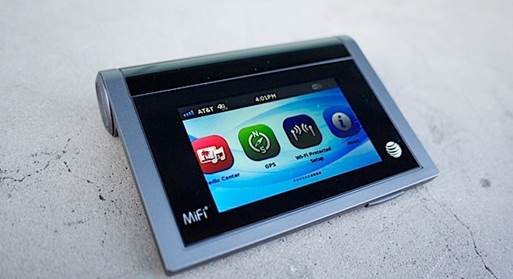There are two extremely important factors
when it comes to choosing a mobile hotspot: speed and battery life. Then, it
should be portability, with the design underlying the hardware. So, the idea of
the MiFi with a touchscreen makes us see it as an odd luxury, a kind of things
we can only find in a SkyMall directory.
This is why we are attracted to the MiFi Liberate,
the first 4G LTE MiFi by Novatel Wireless with a built-in touchscreen. While it
may be the same gimmick, indeed, the interface provides quick access to
important parameters such as data use. However, Novatel did not intend to leave
it like this: the Liberate has features that we would never dream of, which was
contributed to the MiFi, including media streaming, GPS and even basic
messaging application. Fortunately, the addition of such features does not
increase the price: it's available at $50 on a new two-year contract with AT&T.
How well does it work? Let's find out.

The
MiFi Liberate
Hardware
On the outside, the Liberate looks almost
like a Magic Trackpad’s miniature thanks to the wedge-shaped face and a large superficial
area. It has the size of 99.5x73.1x8.8mm and weighs 120g (4.05x2.88x0.34 inches,
4.26 ounces), and it is undeniable stubby, slightly larger and heavier than the
previous MiFi. However, perhaps it is the best-looking MiFi, with sharp edges
and gray glossy black surface. Located to the left of the cylinder pin is the
power button, while the micro-USB port lies on the right side. There is a Reset
hole at the rear, along with a microSD slot cover, which can be adapted to the
memory cards of up to 32GB. Inside the case mentioned above is the 2900mAh
lithium-ion battery.

Of
course, the main attraction is the TFT 2.8-in touchscreen.
Of course, the main attraction is the TFT
2.8-in touchscreen. It is not a particularly attractive display, with a
resolution of 400x240 and a modest narrow viewing angle. While it is a
capacitive screen, the speed here leaves so many regrets. Sometimes we had to
tap the screen a few times before it reacted, and we encountered some problems of
scanning the screen when scrolling through the list. It took one second for the
internal accelerometer to rotate the screen when we flipped the device upside
down. Obviously, we were willing to give it a rest due to the minor importance of
the touchscreen on the MiFi, but based on the advanced features of the device,
we were expecting more than an acceptable attempt.
Setting up the Liberate is quite simple.
Just pull the tab that separates the battery connection, turn it on, and you
will be presented one convenient setup utility that lets you know the SSID and
the WPA password. Do not worry if you forget about it; just start the
connection details application to review it. You can also change the password
by going to a particular website, which is great step forward in terms of
security than other MiFi devices with static password.
Software

The
Liberate runs on an exclusive Linus platform with a limited system of apps and functionality.
The Liberate runs on an exclusive Linus
platform with a limited system of apps and functionality. But in fact, there
are pretty special applications on the MiFi. A status bar lies on the
interface, which includes 10 shortcut icons that you can navigate by scrolling
horizontally across the screen. With one shot tap, you can explore the
connection details, the data use and a list of connected devices. We noticed
that the ability to quickly test this data use was quite useful, especially
since AT&T made monthly mandatory quota of 5GB data for each user.
Regarding the settings, you can turn on the
airplane mode, cellular data and roaming; adjusting timeout, the screen and the
screen brightness, enabling sound alerts and even change the WiFi coverage –
"high" has the best distance whereas "low" saves battery
for the Liberate. In terms of security, the Liberate supports VPN pass-through,
WiFi Protected Setup, NAT Firewall, anti-CSRF, session timeout, stop and try
again hash password administrator.
It is curious that the Liberate can receive
text messages, but you cannot send anything due to the lack of keyboard.
Therefore, the message feature here is limited mainly to the warning from
AT&T service or, you know, text messages are occasionally lost. The lack of
two-way communication feels like a case of negligence, and it emphasizes the
strangeness of having messaging feature on the MiFi.
As we mentioned earlier, the Liberate is
unique in that it can act as a form of a DLNA media streaming server or through
a microSD card slot. Load up your favorite media card, access the panel based
on any browser on any device you are using and start the file transfer. You can
also transfer music directly to a DLNA-support device by choosing Liberate from
that item’s DLNA interface. We tried it on the iPad and laptops, and it worked
pretty well, as we did not have any problems. Though it was smart, we were wondering
if it was really necessary – we could hardly think of any scenario where
smartphones or tablets would not do the same thing.
Last but not least, the Liberate adds GPS to
any device that does not seem to have this feature. We connected the Liberate with
a MacBook Air and indeed, it determined our position correctly on the map, the
right side of the road where we were standing. Most smartphones have GPS at the
moment so this is somewhat a limited functionality, but it's there if you want
it.